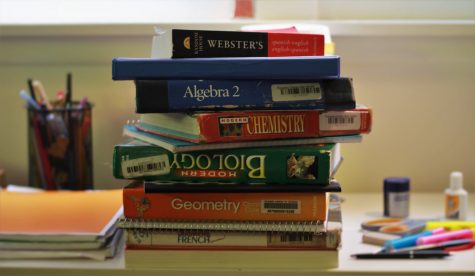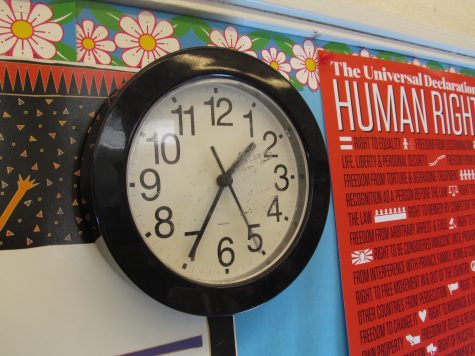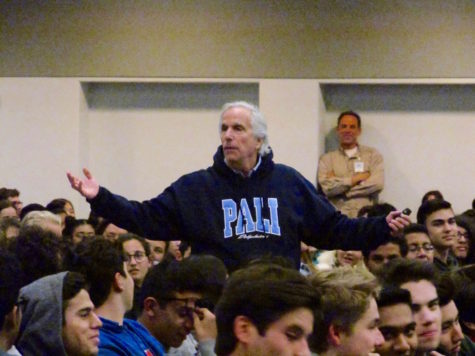Don’t Brake The Breaks
Students need leisure now more than ever.
 Everyone recognizes Leonardo Da Vinci’s “The Last Supper,” a painting that depicts Jesus and his disciples’ last meal together. Little do people know, however, that artist Da Vinci took long periods off from his work to sit and daydream. When asked about his work ethic, Da Vinci allegedly replied, “The greatest geniuses accomplish more when they work less.”
Everyone recognizes Leonardo Da Vinci’s “The Last Supper,” a painting that depicts Jesus and his disciples’ last meal together. Little do people know, however, that artist Da Vinci took long periods off from his work to sit and daydream. When asked about his work ethic, Da Vinci allegedly replied, “The greatest geniuses accomplish more when they work less.”
 While most students may not possess Da Vinci’s so-called “greatest genius,” perhaps the majority would benefit from a little more free time. Students attend high school for six hours a day, five days a week — resulting in burned-out teenagers who often struggle to pay attention in class. However, many administrators, parents and some students believe that this is the best way to learn. To them, taking frivolous breaks during the day is unreasonable and a waste of time.
While most students may not possess Da Vinci’s so-called “greatest genius,” perhaps the majority would benefit from a little more free time. Students attend high school for six hours a day, five days a week — resulting in burned-out teenagers who often struggle to pay attention in class. However, many administrators, parents and some students believe that this is the best way to learn. To them, taking frivolous breaks during the day is unreasonable and a waste of time.
Contrary to this popular notion, data shows that working fewer hours per day increases productivity. According to The New York Times, a Swedish hospital reported experiencing high numbers of employees calling in absent. The hospital decided to launch a six-hour work day mandate in the orthopedics unit to test whether the decrease in working hours had any effect on workers’ performance. The results were telling: there was a significant increase in attendance and efficiency. The executive director of the project, Anders Hyltander, reflected, “The unit is performing 20 percent more operations, generating additional business from treatments like hip replacements that would have gone to other hospitals. Surgery waiting times were cut to weeks from months, allowing patients to return to work faster and reducing sick leave elsewhere in the economy.”
If shorter hours benefit the working people, there’s no reason why it can’t have a similar impact on high school students. If the U.S. education system can implement shorter school days, students can learn with efficiency and spend the rest of their time doing what they enjoy. Free time is crucial in a student’s schedule in order to allow for more time to get creative. Many Pali students have other commitments besides classes, such as jobs and extracurriculars.
Junior and dancer Sophie Groenwold takes ballet classes almost every day of the week after school. “For my situation,” she said, “I would appreciate fewer school hours, considering how I have an extracurricular that takes up a lot of would-be study time.”
According to CNN, research found that the human brain works best in intervals. Contrary to the widespread belief that 10,000 hours of practice is needed to excel at anything, what separates the extraordinary from the mediocre is the way one practices. Ideally, the brain should learn for 60 to 90 minutes at a time before taking a break. Those who practice in short durations gain more technique, discipline and results. Spending time wisely is not synonymous with working long hours. Instead, it means working productively.
Timothy D. Walker, an American teacher in Finland, wrote an essay published in The Atlantic about his exploration of the phenomenon. He let his 5th grade students take short, 15-minute recesses after every 40-minute period of studying. He was inspired by the findings of Anthony Pellegrini, a professor of educational psychology at the University of Minnesota. Pellegrini found that students who had 40-minute class sessions were more focused and attentive. “When break times are teacher-directed,” Pellegrini said, “the recess loses its value. It’s free-play that gives students the opportunity to develop social competence. During these times, they not only rest and recharge—they also learn to cooperate, communicate and compromise, all skills they need to succeed academically as well as in life.” If students have a chance to redirect their attention during breaks while acquiring pertinent life skills in the process, consider it a double-whammy.
Changing the duration of school days or implementing more breaks is a huge shift for many institutions. Parents who send their kids to school may be skeptical because the main purpose of school is to learn, not to play. Some claim that administrator salaries would become objects of controversy because teachers would be paid less. Changing routines like bus schedules or pick-up times is expensive and tedious.
But, nonetheless, nothing too drastic has to happen to make students’ time at school more productive. Since primary schools already offer short class periods and school days, the first changes to be made can start from there and up. Parents would also be more willing to adhere to the schedule changes and observe the positive effects the new routine has on their children.
Teachers who let students spend less time in the classroom would profit from this system too, if they allow the process to play out. When the government sees how much more students are gaining from their education, it could potentially increase compensation for the inconveniences involving administration salaries and transportation. Schools that follow the proposed agenda will notice the boosts in creativity, learning, efficiency and the overall mood of the students. The sacrifices to be made will seem minute compared to the benefits.
Palisades High AP® U.S. History teacher Ms. Christopher believes that letting her students take a five-minute break halfway into the period is beneficial to their learning. “Yes, I do see a difference in my students when we return to class from a break,” she said. “The breaks seem to allow students to regain focus and work not only more productively but efficiently throughout the remainder of the period.” In terms of taking the next step forward, Ms. Christopher added, “I think that there should be continuous information to teachers about the benefit of allowing students to take breaks and encourage all teachers to do so.”
Long classes and loss of attention could make students less eager to learn and unable to concentrate. School is often discussed with a negative connotation, but with the brain working productively and resting to re-energize, the idea of going to school can be something to look forward to. After all, school is for the benefit of the student, and students who learn productively can make better use of their time. Other important aspects of students’ lives, including social relationships and enriching activities, are just as important as learning in the classroom.
It’s strange to think that as kids get older they study more, yet they are only as focused as their elementary school selves. Breaks such as nap time were unwanted back in first grade, but high school students need them now more than ever.



